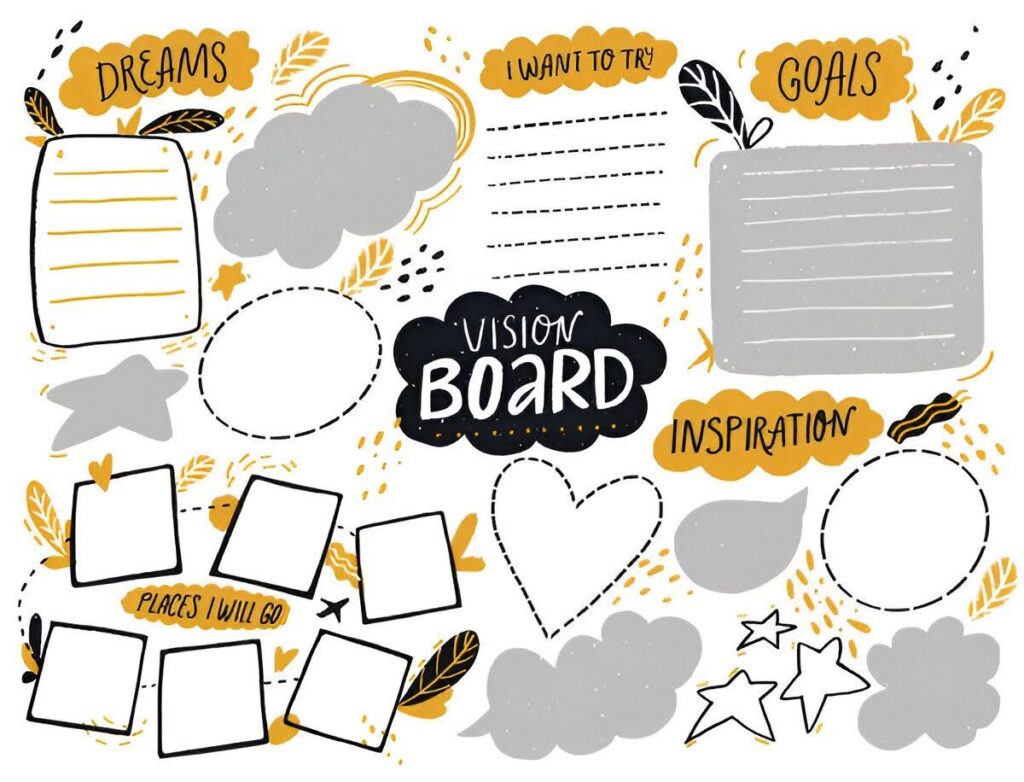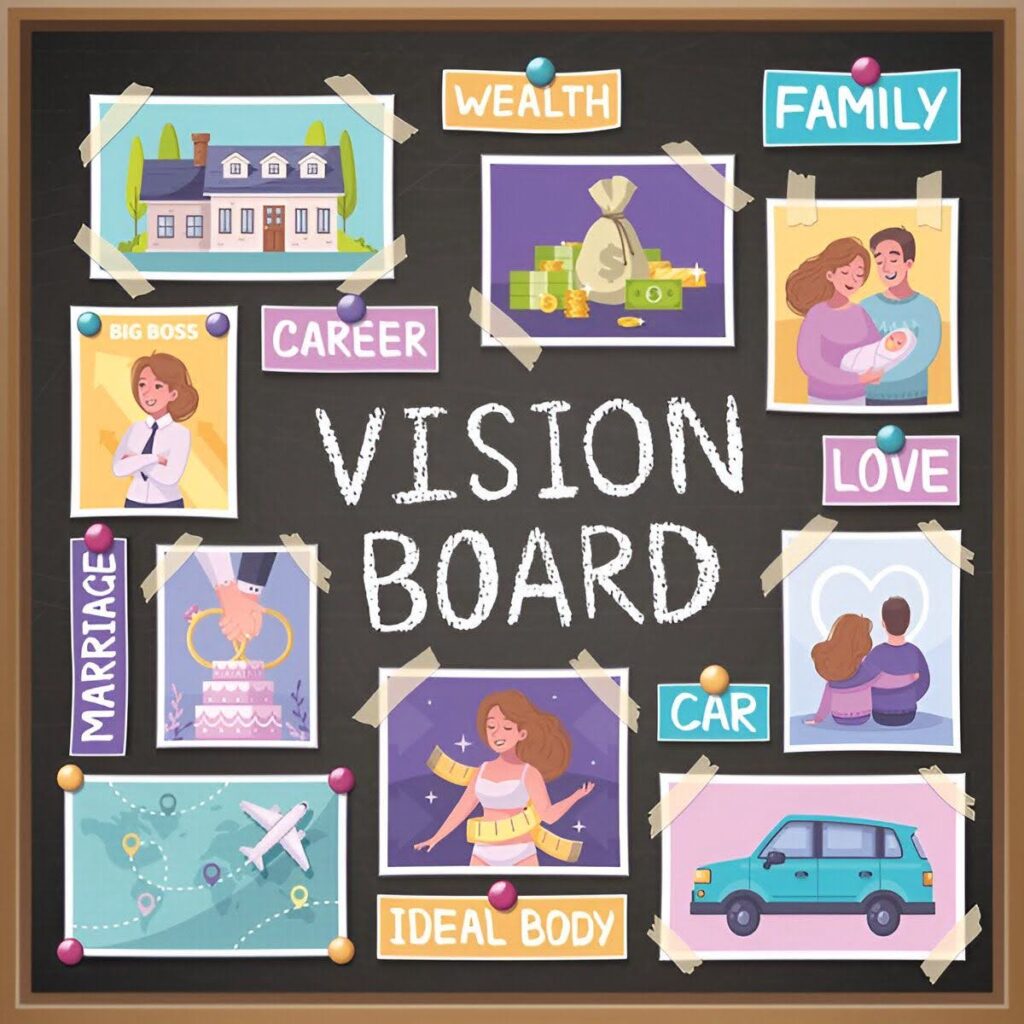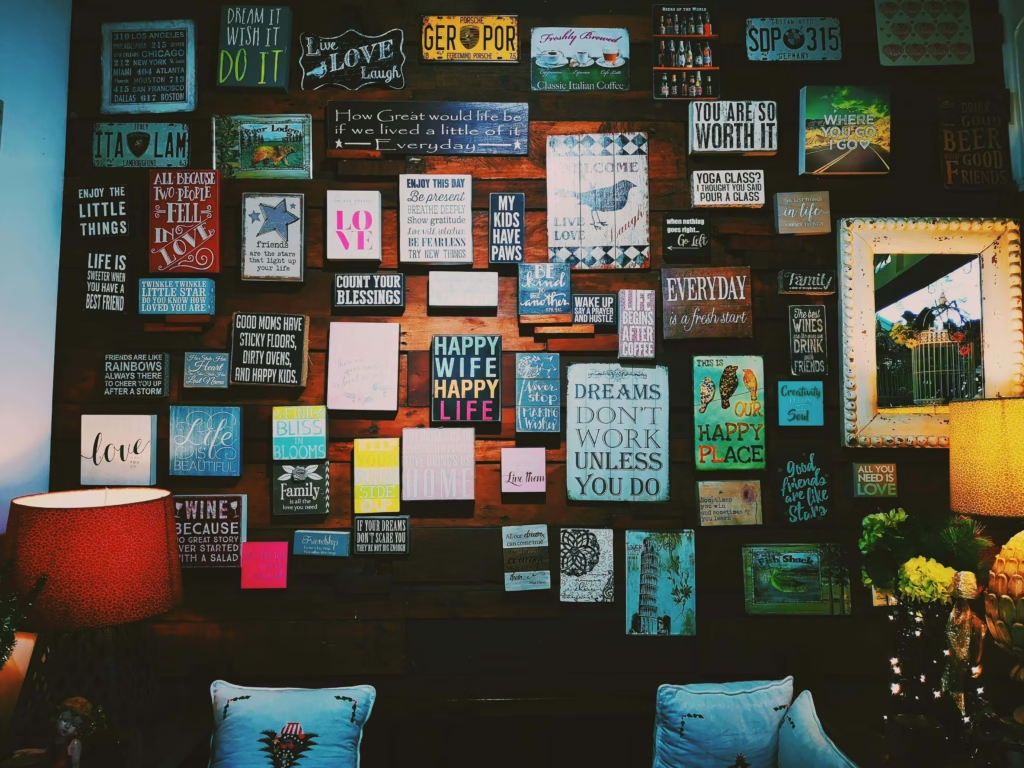What is a vision board or definition of a vision board?
A vision board is a graphic depiction of one’s goals, dreams, and aspirations. It usually consists of a collection of pictures, quotes, and other materials meant to motivate and encourage the individual. By keeping regular reminders of one’s objectives, understanding a vision board helps visualize their manifestation into reality. What is a vision board.
Vision boards were inspired by the Law of Attraction, a well-known early twentieth-century concept based on positive thinking and imagery, which should produce positive results. Vision boards were made popular in the early 2000s. Particularly with the publication of Rhonda Byrne’s book “The Secret,” which emphasised the importance of visualisation in achieving one’s goals.
Since then, understanding a vision board has become a common practice in self-help and personal development circles.
“When you have a dream, you’ve got to grab it and never let go.” -Carol Burnett
Do vision boards really work?
While vision boards have grown in popularity as a tool for personal growth, their effectiveness is sometimes questioned. However, a growing body of research backs up the science behind vision boards and their ability to help people reach their goals.
Relevant blog to read: Top Vision Board Questions for Women to Empower Their Goals
Science Behind Vision Boards and Visualization:
- Value Tagging: Neuroscientist Dr. Tara Swart claims that understanding a vision board “primes the brain to grasp opportunities that may otherwise have gone unnoticed.” This is so because the brain values images more than written words; hence, visualising is a more successful approach to expressing intentions.
- Repetition: Regularly seeing a vision board helps people to lessen their fear response related to new difficulties, thus increasing their likelihood of action towards their objectives.
- Positivity: Making a vision board helps one to increase good feelings, energising the brain and inspiring people to pursue their goals.
Scientific and Anecdotal Evidence of Vision Board Effectiveness
- Anecdotal Evidence: Many people, including celebrities like Steve Harvey, have claimed to use vision boards to help them achieve their objectives and realise their wishes. While anecdotal data is inconclusive, it indicates that understanding a vision board can be an effective tool for personal development and achievement.
Types of Vision Board and What to Include
Understanding a vision board also involves recognizing different types of vision boards, like physical and digital. Each type has distinct advantages and can be modified to meet certain needs.
1. Physical Vision Board
Materials
- Poster Boards: A classic choice that allows for creativity and personalization. Utilise publications, printed images, quotes, and markers.
- Cork Boards: Ideal for pinning and rearranging items quickly. You can update it as your goals change.
- Canvas Boards: Take a more artistic approach by using paint, fabric, or other materials to create a visually appealing representation of your goals.
What to Include:
- Images: Photographs of your goals (e.g., vacation spots, dream residences, job achievements).
- Quotes: Inspirational statements that relate to your aims and motivate you.
- Symbols: They are the items or emblems that have personal importance and express your aspirations.

2. Digital vision boards:
Tools and apps.
- Vision Board Apps: Consider using apps like my well-being or Canva to effortlessly build and personalize digital vision boards.
- Online Platforms: Tools such as Pinterest and Google Slides can be used to create visually appealing collections of images and quotes.
What to Include:
- Images and videos should be of excellent quality and inspirational. Digital boards can also contain video snippets that elicit strong emotions.
- Links: Include links to resources or articles that can help you achieve your goals, making it easy to obtain inspiring content.
- Quotes and Affirmations: Inspirational statements that relate to your aims and motivate you.
- Symbols: They are the items or emblems that have personal importance and express your aspirations.

Tailoring Vision Boards for Specific Goals
- Career Goals: Include photographs of your ideal job, organizations you respect, or role models in your industry. Include quotes about success and ambition.
- Relationship Goals: Use images that symbolize the types of relationships you want, such as friendships, romantic partnerships, or familial connections. Include affirmations of love and connection.
- Health goals: Include photos of fitness, good eating, and self-care habits. Include inspiring words about wellness and self-love.

Such different types of vision boards are beneficial, as you can modify them as per your needs.
Relevant blog to read: How to Make a Vision Board: A Step-by-Step Guide
Problems With Vision Boards: Common Pitfalls to Avoid

While understanding a vision board can be an effective tool for manifestation and goal setting, there are a few common traps that people may run across. Understanding these obstacles can help you make better use of vision boards.
1. Excessive reliance on visualisation without taking actionable steps
The Problem:
Many people feel that simply imagining their goals will lead to their accomplishment. This perspective can lead to ease, in which individuals fail to take the essential steps toward their goals.
Solution:
- Develop an action plan. Along with your vision board, create a detailed plan outlining the particular measures you must take to attain your objectives.
- Divide these steps into smaller projects with timelines.
- Set milestones: Set short- and long-term goals to track your success. This will help you stay motivated and focused on your goals.
2. Creating unrealistic expectations or becoming fixated on material outcomes.
The Problem:
Vision boards can sometimes create unreasonable expectations about what can be accomplished and when. Focusing primarily on material outcomes can also hinder personal development and contentment.
Solution:
- Prioritise process over outcome. Change your perspective to value the journey rather than the destination. Include personal growth objectives, such as skill development or emotional well-being, on your vision board.
- Practice thankfulness: Take regular time to reflect on your accomplishments and express thankfulness for your growth. This can help you feel less dissatisfied and more grounded.
3. Focusing on certain images or goals
The Problem:
A strong commitment to specific pictures or results might lead to frustration when those goals do not come true. This obsession can lead to dissatisfaction and feelings of failure.
Solution:
- Maintain Flexibility: Allow your vision board to evolve as your aims and desires shift. Regularly update it to reflect new goals and insights.
- Use positive affirmations to emphasize growth, resilience, and adaptability. This can help to reinforce a positive mindset while lowering the emphasis on specific outcomes.
Relevant blog to read: Inspiring Examples of Vision Boards to Visualize Your Future
Tips to Make Your Vision Board Effective
To enhance the effectiveness of understanding a vision board, consider these tips:
1. Positioning the Vision Board for Daily Visibility.
- Select a Prominent Location: Place your vision board somewhere you’ll see it every day, such as your bedroom, office, or a common area of your home. The more you see it, the more it will remind you of your objectives.
- Create a ritual: Create a daily habit of engaging with your vision board. Spend a few minutes each day meditating on your goals, visualizing your success, and experiencing the emotions that come with attaining them.
2. Regularly updating the board as the goals evolve.
- Stay Current: As your desires and circumstances shift, update your vision board to reflect your new objectives. This keeps it relevant and in line with your current preferences.
- Incorporate new inspirations: Add new photos, quotations, or symbols to your collection on a regular basis that reflect your changing vision. This might also boost your motivation and excitement.
3. Combining Vision Boards, Positive Affirmations, and Journaling
- Use Affirmations: Enhance your vision board with positive affirmations that support your goals. To build your conviction in your ability to manifest, write down, and repeat sentences that reflect your aspirations on a daily basis.
Relevant blog to read: Positive Affirmations for another person - Journaling: Keep a journal to record your ideas, feelings, and progress with your vision board. Reflecting on your path can help you gain insights, define your goals, and strengthen your dedication to achieving them.
Relevant blog to read: Top 10 Inspiring Ideas for Things to Write in a Journal
These tips can help you to build a more potent and successful tool for attaining your dreams.
Conclusion
The process of manifesting your desires is as important as the final product and you may learn and improve as you go. Visit our app, mywellbeing.me if you’re interested in practising the art of creating a vision board. It offers a wealth of options, including a collection of images, phrases, and symbols.
Relevant blog to read: Top 10 Vision Board Ideas for Students 2025
Frequently Asked Questions
Vision boards are visual tools meant to help one clearly and reflect personal objectives and desires in many domains of life.
Update your vision board often—ideally every few months or if your objectives change.
Indeed, by picturing success and inspiring practical, achievable activities, vision boards can be quite successful for professional goals.
The period is different, but regular interaction with your vision board and implementation of practical ideas improve its efficacy.
Both digital and physical vision boards can be effective, depending on personal preference and consistent interaction.
Listen to our Podcast
Also available Youtube and Apple Podcast.
Author’s note
Thank you for taking the time to focus on your well-being and for being your own cheerleader in this journey called life. I truly appreciate you for choosing to invest in yourself today, and I’m honored that you spent a part of your day here. Remember, every small step you take matters, and you’re doing an amazing job. Keep going—you’ve got this!
💛 Support Our Mission
If you find our content helpful and inspiring, consider supporting us with a small donation.
Your kindness helps us grow, write more meaningful articles, and reach more hearts.
You can donate via PayPal — every bit counts! 🙏






19 Comments